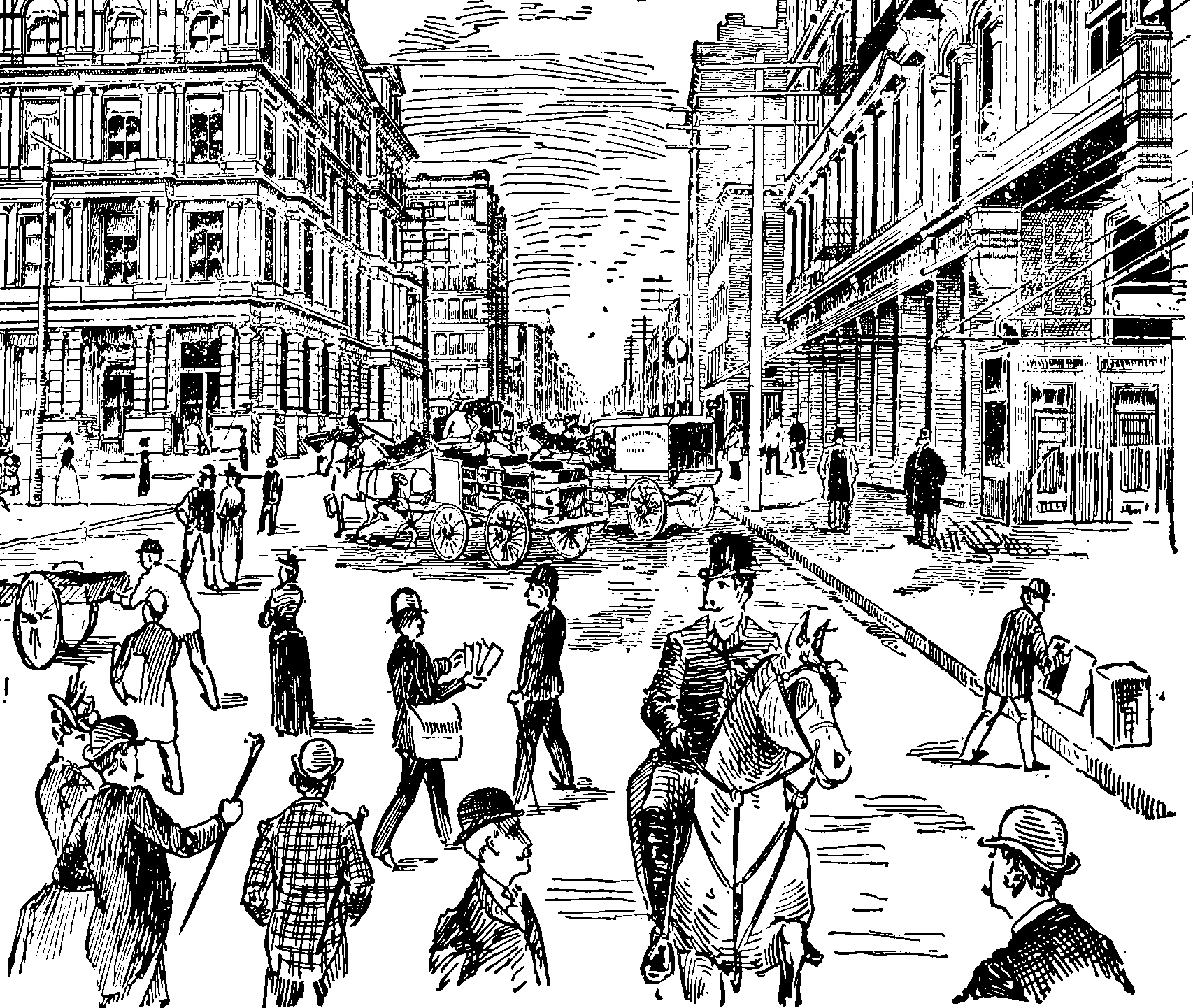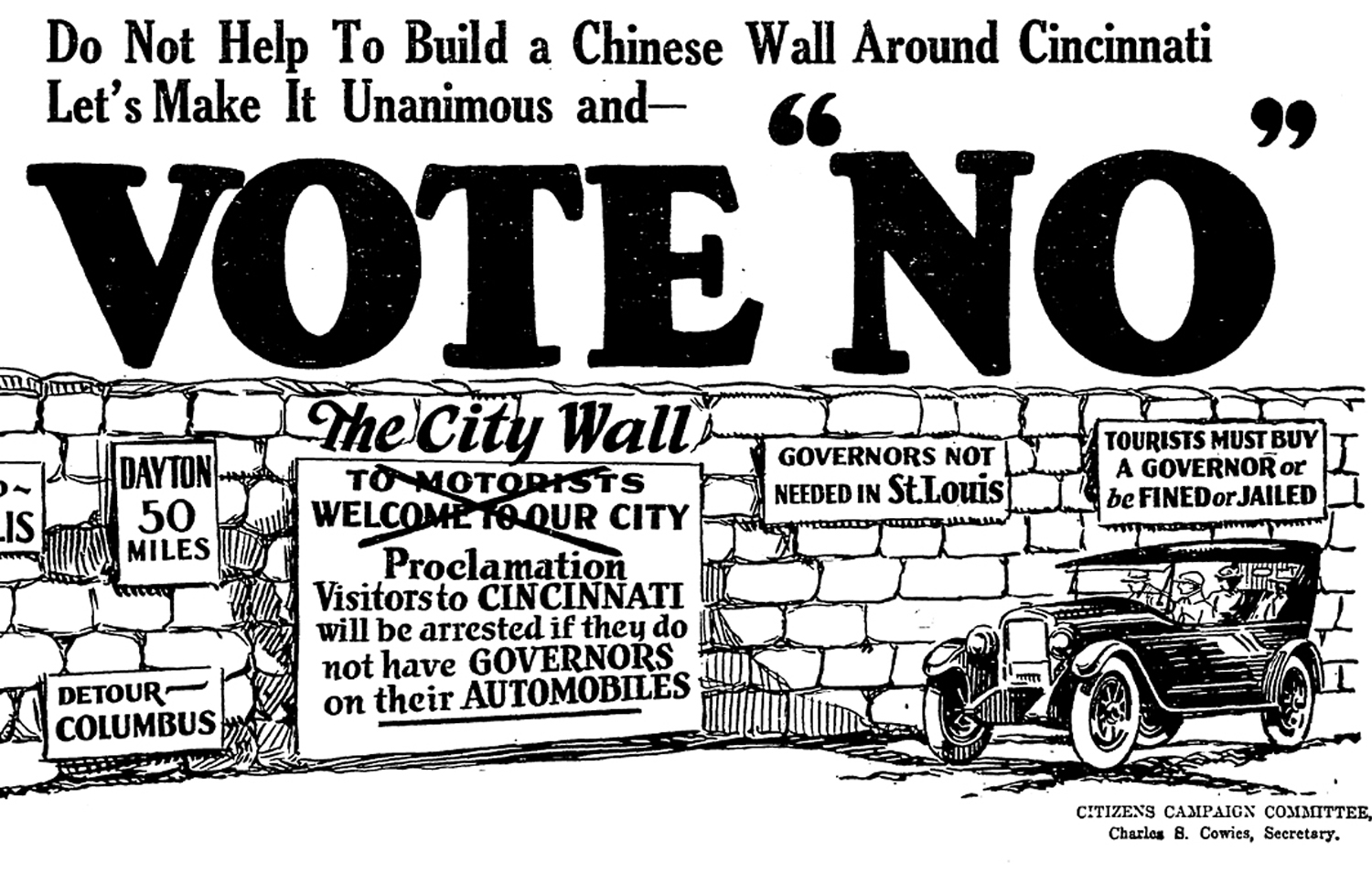Cincinnati was not yet an automobile town in 1920. Just 10 years later, however, the motor car ruled, causing the city to splurge on parkways and highways and to confine pedestrians to crosswalks and sidewalks.

From D.J. Kenny's “Illustrated Guide to Cincinnati” (1893), digitized by the Public Library of Cincinnati and Hamilton County
The transition wasn’t easy or simple. Before 1920, Cincinnati’s streets were crowded with people on foot, crossing wherever was most convenient, even stopping in the middle of the street to chat. Horse-drawn carriages and wagons hauled passengers and freight. The most common motorized vehicles were the electric street cars, which were confined to their tracks. The automobile changed all that.
Horse-drawn vehicles and electric streetcars killed a fair number of people, to be sure, but the motor car quickly notched more than 100 fatalities and many more injuries every year. As early as 1917, Cincinnati tried to negotiate a truce between foot traffic and motor traffic with a series of new laws. Automobiles could go no faster than 8 miles per hour in the business district and 15 miles per hour in residential districts. In return, pedestrians were restricted to sidewalks and crosswalks. Among the first arrested was Miss Ella Bright of 538 Howell Avenue, Clifton, a teacher at Woodward High School. She did not care for the attitude of the city policeman who accosted her. According to The Cincinnati Enquirer [June 7, 1917]:
“She declared she had been upbraided unduly by an officer because she crossed the street in a manner which was a violation of the traffic laws after alighting from a street car.”
In August of that year, Mrs. John Mongan, 4217 Glenway Avenue, Price Hill, was arrested for striking a police officer who grabbed her arm as she executed a “Dutch Cut” (diagonal jaywalking) across the intersection at Sixth and Race downtown.
Fatalities continued to mount, and motorists generally ignored the speed limits seemingly designed to control horses rather than gasoline-powered vehicles. In June 1922, an “Initiative Committee” announced that it would begin to gather signatures to place on the next ballot an ordinance requiring all automobiles operating within the city limits of Cincinnati to be equipped with a “mechanical speed regulating device.” These “governors” would physically prohibit an equipped vehicle from traveling more than 25 miles per hour.
The Initiative Committee, chaired by attorney Eli G. Frankenstein, included Fred Dryer, a railroad employee; George Lishawa, auditor of the Cincinnati, Hamilton & Dayton Railroad; Eugene Schaefer, president of the Schaefer Rubber Company; and J.F. Walton, letter carrier for the Post Office. Not listed as a member of the committee, but later revealed as the only donor to the initiative, was Wyoming resident Walter F. Pentlarge, president of the United States Bung Manufacturing Company.
None of the committee members made public statements about their motivation, but it’s possible to see the railroad men bemoaning the loss of passengers to motor cars and the mailman likely resented the danger presented by automobiles along his route.
Walter Pentlarge is a curious case, because he was one of those dangerous drivers the proposed ordinance was aimed at. In 1915, he was driving down Linn Street when he struck a 4-year-old boy who had darted into the street. The boy, only slightly injured, was ruled at fault. From whatever motivation, Pentlarge contributed the entire $1,392.66 budget to promote the speed regulator ordinance.

From The Cincinnati Post (May 1923), image extracted from microfilm by Greg Hand
Unfortunately, 2,200 individuals, including some large corporations, donated $7,365.50 toward the Citizens’ Campaign Committee to oppose the initiative. Lined up in opposition was the Chamber of Commerce, the Academy of Medicine, the Businessmen’s Club, the Central Labor Council, and seemingly every civic organization in town. Realtors predicted property values would plummet. Insurance executives claimed rates would soar. The manager of Cincinnati’s Fall Festival (predecessor to Oktoberfest) predicted no one from out of town would drive into Cincinnati anymore.
Ignoring the business and financial prophecies, supporters of the ordinance framed it as a matter of life and death:
“Fellow voters, this ordinance is a serious piece of business. Your vote may mean your life. The passage of this measure may mean the lives of your children. It is non-partisan. We have no ax to grind. We have no politicians to please. We want to make Cincinnati safe for Cincinnatians!”
The anti-ordinance crowd dragged out a bona fide politician, Congressman Alfred G. Allen, who declared the proposed legislation absurd:
“There is not the least doubt in my mind but that it would, when taken into the courts, be ruled upon as being an unreasonable ordinance and for that reason unenforceable.”
While the pro-ordinance side bought economical quarter-page advertisements, their well-funded opponents splashed their message across expensive full-page spreads, condemning the speed governor as a barrier to progress:
“The loss of business to Cincinnati will be enormous, for the ordinance builds a wall around the city excluding every motor car from entering unless equipped with a governor. It will isolate the city and make Cincinnati the butt of national ridicule.”
Most importantly, the opponents noted, speed governors were useless going downhill, when the driver could shift into neutral and coast at the highest speeds his wheels would allow.
It was hardly surprising that the proposal died at the ballot box. Only 14,012 voters supported the ordinance, while 92,427 opposed. That year, Cincinnati recorded 103 automobile fatalities. By 1929, the annual toll had risen to 157 deaths caused by motor vehicle accidents. In 1934, Cincinnati logged 201 traffic deaths.
By comparison, 64 people died due to automobile accidents in Cincinnati last year.





Facebook Comments